Matador Network's Blog, page 121
September 16, 2024
Want to See Machu Picchu Next Year? Buy a Permit Before They Sell Out

There are multiple hiking trails that lead to the ancient city of Machu Picchu: the Ancascocha Trail, the Salkantay Trail, the Lares Trek, etc. But the most popular of them all is the Inca Trail, and to hike it, you need a permit.
The Inca Trail is the traditional path that the Incas used to reach Machu Picchu in the 15th century, and it is the only route that will have you arrive directly to the Incan ruins on foot without having to take a train or bus in between.
To preserve the historical route and to prevent overcrowding, the Inca Trail is highly regulated: Travelers need a permit and be accompanied by a licensed guide to access it and trek all the way to Machu Picchu.
The 2025 permits to hike the Inca Trail will be available for purchase on October 1, 2024, and are expected to sell out fast.
“Travelers wishing to hike the iconic Inca Trail to Machu Picchu should be aware that permits are limited to 500 people per day. Of these, approximately 300 are allocated for porters and guides, leaving only 200 permits available for travelers,” locally owned and operated tour operator Alpaca Expeditions says in an email.
The Inca Trail is closed in February due to extremely wet weather conditions and maintenance, but it is otherwise open every day throughout the remaining 11 months of the year. May, June, July, and August are considered the peak season, when the trail and the ruins tend to be busier. Naturally, getting a permit for those months can be difficult if your trip isn’t planned well in advance. While the rainy season in the Peruvian Andes starts in November and ends mid-March, Miguel Angel Gongora Meza, director and cofounder of tour operator Evolution Treks Peru, recommends travelers who are not afraid of wet weather to plan a trip from March to May, and from September to mid-December when the crowds are much thinner.
The classic Inca Trail is a challenging four-day, three-night hike that starts in the city of Cusco, covers 26 miles, and involves 1574 feet of elevation. However, tour operators tend to offer shorter and longer versions of the Inca trail, including two-day, five-day, and seven-day treks for those who either want a less strenuous or more arduous experience.
Before you select a tour operator for your Inca trail adventure, make sure to look into how they treat their workers. Some tour operators have been known to exploit their porters, forcing them to carry more than the maximum weight allowed, and not providing them with decent meals or sleeping conditions while on the trail. Take the time to watch the movie “KM 82” which highlights those issues.
To secure a Inca Trail permit before they sell out, reach out to the tour operator of your preference with your dates and with your passport information. 
A Look Inside the Vagabond Life of Yoga Academy International’s Founder

Taking inspiration from Lauren Rudick’s career path comes as naturally as the passion in her voice as she explains it to you. The founder of Yoga Academy International, Rudick leads yoga retreats and Yoga Teacher Trainings in far-flung locations including Marrakech, Morocco, and Tulum, Mexico. For any aspiring to find a “travel job,” the biggest takeaway from Lauren’s story is that the best path forward may be to ditch the word “finding” in favor of “creating.” Rudick, who encourages those seeking a similar path to “trust your intuition and be bold enough to jump in deep even if the water is murky,” exemplifies the ideal professional global vagabond in the sense that she found a lifestyle she loved and built a business to fit it, rather than the other way around. Here’s how she did it.
How traveling the world helped Lauren Rudick build Yoga Academy International
Photo courtesy Lauren Rudick
Yoga Academy International retreats are designed as all-encompassing experiences that disconnect attendees from their normal routines to fully engage with their inner selves. Rudick, now 39, loves teaching the philosophy and soul of yoga. She first tried yoga 20 years ago in her hometown of Montreal. She grew up in a Jewish school where she learned to read and write in English, French, Hebrew, and Yiddish. Coming out of university, she knew she didn’t want to live a traditional suburban life. Yoga, and the ability to speak multiple languages, helped her find comfort in her own skin. Travel – and yoga – became her escape.
“From the first moment, it was just a love story,” she says. “I felt so good in my body. I felt beautiful, I felt challenged. It was hard, and athletic, and dancy.”
Following a breakup and a nudge from her yoga teacher, Rudick decided to get her YTT certification herself in Mexico.
“I ran away to Mexico and it changed my life forever,” she says. “First solo trip, first time living next to the ocean. It was the first time I’d ever seen surfing in real life. And I met all these women who were older than me, and single, and traveling around the world by themselves. I was like, “Whoa, there are other paths!”
Bouncing around Mexico after the yoga teacher training, Rudick eventually found herself in an $8-per-night hostel in La Paz. She was scared – to be alone as a woman, to be without a job or a partner or a straight path forward. But objectably, sitting there alone in a foreign country, she realized this was the freest she’d ever felt.
“That was the first moment I realized no one’s going to save my life but me,” Rudick says.
She met a group of surfers at the hostel who invited her to stay with them on the beach. At first hesitant, she built a rapport with them and agreed to their offer of a tent and sleeping bag.
“We got there right at sunset, and in Baja the sunsets are so pink,” Rudick says. “I sat there watching these men surf, and it was the most beautiful thing I’d ever seen. I thought, this is the most romantic moment of my life – and I’m sitting here alone, on a rock. I was proud of myself.”
Life on the road drew her in. She eventually found work on cruise ships, as a nanny, and a host of other “travel jobs.” Through them all, the desire to teach yoga remained poignant.
“I kept telling people I was a yoga teacher, it just felt so important to define my sense of self that way,” Rudick says. “I’d worked so hard getting through the yoga teacher training.”
From high to low, to high again
Photo courtesy Lauren Rudick
In the 2000s, yoga teacher training wasn’t as prevalent as they are now. Nor were yoga teachers. In this sense, Rudick talked her way into becoming one, simply by constantly repeating that she was qualified.
“I used to teach in the hostels, I would teach on the cruise ships,” she says. “In China I was invited to teach at a local studio, which was so cool because I got to teach people who didn’t speak English. I could try things, and no one really knew (if I messed up).”
Rudick felt like the best of herself when teaching yoga. She took more training in Australia and attended conferences and yoga industry events globally. Arriving back in Canada in the 2010s Rudick landed a gig teaching yoga full-time.
“I made like $19,000 my first year, busting my butt,” she says. “During the two years I was away my friends had mostly all started careers, started relationships and were getting married. Once again I felt like a total loser, like I was so far behind.”
Rudick first had the idea of hosting yoga retreats while looking at Yoga Journal magazine. An ad for a prominent teacher hosting retreats around the world planted the seed for Rudick to host her own, more fully combining her passions of travel and yoga. The business idea came while attending a yoga industry conference in Hong Kong, where Rudick found herself struck by the level of legitimacy presented by the businesses targeting yogis.
“That was when I decided that I want to be part of this industry, and not as a consumer but as a player,” Rudick says.

Photo courtesy Lauren Rudick
The early days of her business consisted of building a Facebook page, trying to get publicity in magazines and on the web, and generally putting herself out there as the host of international yoga retreats. Rudick put the skills she learned at an event planning job to work at yoga events and festivals, notably landing a gig as a production manager at Wanderlust Festival, an annual traveling yoga festival. She worked her way into a teaching role, which helped establish her name with an international audience.
She organized her first retreat in Morocco in 2014. Six months later she held a retreat in Costa Rica, and she made enough – about $1,000 – to live in the country for a month after the retreat. That was all the motivation she needed. She learned to surf during that month, and landed a gig teaching yoga classes at local hotels. She ended up staying in Costa Rica for three years, and led her first teacher training through a friend’s company.
This experience inspired Rudick to add YTT programs to her plan, and to do them well – in the manner that her trainings had been conducted rather than in a trendy, contemporary fashion.
“One day I was meditating on the beach and I had this vision, and it was so clear,” Rudick says. “My website is black and white because it was clear as night and day that this is what I needed to do. I saw people meditating in a circle on the beach, I saw sunsets, I saw people dancing, and me teaching yoga. I could feel it. I got out of that meditation, and I turned to my dog and said, ‘Tanto, I have to go start an international yoga academy.”
That URL was taken, so Rudick put international at the end and had the name of her website and business – Yoga Academy International.
The school now has a dozen or so programs and retreats, and employs yoga teachers Rudick has come to know and trust over the years. Ideas from teachers are welcome, but the vibe of the school is uniquely hers – it’s grown as she has, and added new retreats and teachings as they’ve made their way into her life.
“I take a step back and am like, ‘Holy shit I built this thing,’ but it started from the ground up,” Rudick says. “It’s been natural, as I’ve lived more experiences in life and as my students have grown and wanted more offerings and I’ve had access to more colleagues, it grew. It’s cool that because I have the credentials to certify, if a colleague or friend comes to me and says, I have this great idea for a training, we can make it work.”
Rudick is proud that she’s able to offer colleagues a chance to bring their teaching dreams to fruition – particularly those who don’t have the accreditation or event planning skill set that she’s built over the years.
“I’m always clear with people when they sign up that you’re not buying a diploma,” Rudick says. “You’re buying a box. We’re going to spend the month filling it with tools and teach you how to use them.”
This approach encourages students to take the teacher training or attend a retreat as a gift to themselves, not as some sort of a career foundation. If a student goes forward with teaching, that’s great – but the first benefit of a Yoga Academy International training is the experience of working on oneself.
For others looking to build a business or career in the same manner she has, Rudick encourages finding a mentor. “I wish I would have had a mentor earlier on. Seek mentorship, and believe in the dream and in your vision. It does sometimes feel like a fight, like I’m fighting for my life. But I think what drove me was this fight to live life on my own terms, and this freedom that came with creating these yoga programs that help other people feel that freedom and that acceptance I felt in my first training. Trust your vision, and put in the work.” 
Learn more about Yoga Academy International
Try Lauren Rudick’s yoga classes online
More like thisTravelI've Worked Remotely Around the World. Here's What All the 'Best Cities for Remote Workers' Lists Get WrongThe World’s Best Pizza Isn’t Served in Naples, but in NYC Says the 2024 Top Pizza Awards

Be prepared to join a long queue at Una Pizza Napoletana in New York’s Lower East Side when Anthony Mangieri and the team return from Italy on October 3. Italy-based the 50 Top Pizza Awards has awarded Mangieri’s sixth restaurant the best pizza in the world.
Opened by renowned pizzaiolo Mangieri in 2022, Una Pizza Napoletana has not only outperformed its American competitors but has also surpassed the revered pizzerias of Naples, the birthplace of pizza.
Mangieri, who is currently enjoying the limelight in Italy, expressed his pride and gratitude for this achievement, acknowledging the significance of the recognition in his 30-year career.
View this post on InstagramA post shared by Una Pizza Napoletana (@unapizzanapoletana)
The internationally recognized judges of the pizza awards might have one of the best jobs in the world, but their standards are impeccably high. The guide explains how Mangieri beat his Italian competitors with passion and by executing the basics perfectly.
“In a country always accustomed to putting everything on pizza, Anthony proposes only the purest tradition in toppings, with extraordinary ingredients. Marinara, Margherita, Cosacca, and a pizza that changes every day, based on market ingredients,” says the awards site.
NYC’s pizza scene has further solidified its global standing, with two additional pizzerias making it to the prestigious list. Ribalta and Don Antonio secured positions at 19 and 30.
While Italy still maintains a dominant presence with 41 pizzerias on the extended list of 100, the US has made significant strides with 15 recognized establishments. Naples demonstrated its enduring pizza prowess with five entries, including a shared second place with Diego Vitagliano Pizzeria. I Masanielli by Francesco Martucci in Caserta in southern Italy comes joint second, and the Mandarin Oriental Tokyo’s The Pizza Bar on 38th takes third.
The 50 Top Pizza World awards showcase the evolving landscape of pizza, highlighting the creativity, innovation, and passion that drive the pursuit of pizza excellence. The list includes pizzerias from countries not traditionally associated with pizza culture. The Philippines, Japan, and China are among some nations in the top 50.
For pizza lovers, here’s the list of the best pizzerias for 2024, according to the 50 Top Pizza Awards.
1. Una Pizza Napoletana, New York, US2.Diego Vitagliano Pizzeria , Naples, Italy2. I Masanielli — Francesco Martucci , Caserta, Italy3. The Pizza Bar on 38th , Tokyo, Japan4. Confine , Milan, Italy5. Napoli on the Road , London, England6. Tony’s Pizza Napoletana , San Francisco, US7. I Tigli , San Bonifacio, Italy8. Sartoria Panatieri , Barcelona, Spain 9. 50 Kalò , Naples, Italy10. Seu Pizza Illuminati , Rome, Italy More like thisNational ParksThe Oldest Hotel Inside a US National Park Is Closing Indefinitely
More like thisNational ParksThe Oldest Hotel Inside a US National Park Is Closing Indefinitely
September 13, 2024
The Oldest Hotel Inside a US National Park Is Closing Indefinitely

California’s Yosemite National Park announced on September 11 that the historic Wawona Hotel, the oldest hotel within any national park in the United States, is closing — potentially forever.
The hotel will “close to allow the National Park Service (NPS) to conduct a comprehensive condition assessment on the hotel complex,” wrote a Facebook post from Yosemite National Park announcing the closure. The closure will go into effect on December 2, 2024, and was deemed necessary following a roof replacement that revealed significant structural weaknesses throughout the building. It’s not the first closure for the hotel, which also closed in 2020 for a hotel-wide replacement of the electrical system.
The Wawona Hotel sits near the park’s southern entrance, along the first wagon trail into the park. The first building was constructed in 1856, when it was called “Clark’s Station.” In 1875, it was sold to a proprietor who renamed it “Wawona,” thought to be similar to an Indigenous American word for “big trees,” as it sits near the park’s largest giant sequoia grove. The building that stands today, painted white in a Victorian style with a massive wrap-around porch, was built in 1879. Several addition have been made since then, though the hotel’s furnishings and decor are still in the style of the late 1800s.

The Wawona Hotel, circa 1880-1890. Photo: Library of Congress/Public Domain
The Wawona Hotel is currently managed by “Yosemite Hospitality,” a sub-brand of Aramark Hospitality, which has contracts with several national parks to run concessions like lodging and dining. Various reports on Yosemite facilities have documented the aging hotel’s structural failures and concerns, and in 2023, a visitor was injured when she fell from a balcony after leaning against a railing that gave way. As first reported by San Francisco-based SFGate, the park had notified Yosemite Hospitality of “extensive deterioration and rot of railings” at the Wawona Hotel in 2022 and 2023, noting that the company had exhibited “inaction to address hazards occurred throughout the year” and “required multiple follow-ups from Service staff to ensure compliance.”
Per the Wawona Hotel’s booking page, “There is no estimated reopening date for the hotel. All guests impacted have been cancelled and refunded directly.”
Visitors who are keen to explore historic hotels throughout the park service still have plenty of options. Busy Yosemite National Park‘s next oldest hotel is the Ahwahnee Hotel, built in 1926. It’s one of many hotels built in a style known as “Parkitecture,” using natural and local materials like stone and lodgepole pines. Many national parks constructed hotels like the Ahwahnee in the early 20th century when tourism to the national parks was gaining popularity, spurred by the expansion of the railroad and the burgeoning conservation movement. The creation of these grand lodges was often a collaboration between private enterprises, like railroad companies, and the National Park Service, which sought to accommodate an increasing number of visitors while preserving the natural beauty of the parks.
View this post on Instagram
A post shared by Yosemite National Park (@yosemitenps)
Many more historic hotels were built inside national parks during the Great Depression as a way for the federal government to create jobs for Americans. These were often managed by the Civilian Conservation Corps, or CCC, a New Deal program responsible for building many infrastructure and recreation projects throughout the US.
The hotels still open today retain much of their original charm and character, and while most have high-end, modern amenities, some still offer rooms with shared bathrooms and historic, oversized fireplaces. The history and grandeur of historic hotels within National Park Service generally make them some of the most expensive in each park, especially as they’re often in prime locations where hoteliers would never be allowed to build today.

A Yellow Bus waiting for passengers outside of the Lake Yellowstone Hotel. Photo: National Park Service/Public Domain
The Lake Yellowstone Hotel: The Lake Yellowstone Hotel, built in 1891, is the oldest operating hotel in Yellowstone National Park and was originally designed in a simple, clapboard style. In 1903, architect Robert Reamer, known for his work on the Old Faithful Inn (built in 1904) redesigned the hotel in the Colonial Revival style, giving it its iconic stately appearance with white columns and a grand portico.
El Tovar Hotel: El Tovar Hotel opened in 1905 on the South Rim of the Grand Canyon and was built by the Santa Fe Railway to cater to affluent travelers arriving by train. Unlike the log-heavy buildings of parks further west, El Tovar was built in a blend of Swiss chalet and Mission Revival styles. It became a symbol of luxury in the early 1900s and, like the Wawona Hotel, is now a National Historic Landmark.
Crater Lake Lodge: Crater Lake Lodge in Oregon’s Crater Lake National Park was completed in 1915 and designed to provide well-to-do visitors with with upscale accommodations overlooking the lake. There were significant construction challenges due to its remote location, but it still stands today, looking much the same as it did more than 100 years ago (though it underwent an extensive restoration in the 1990s).

Many Glacier Hotel in Glacier National Park. Photo: WellyWelly/Shutterstock
Many Glacier Hotel: Many Glacier Hotel was built in 1915 by the Great Northern Railway to accommodate guests arriving to the park by train. It was designed in a Swiss chalet-style, similar to Europe’s alpine resorts, to capitalize on the park’s rugged, high-elevation landscapes that reminded visitors of the Alps. It’s on the shore of Swiftcurrent Lake and is a popular spot for boat tours and kayak rentals, even for guests who aren’t staying at the historic hotel.
Old Faithful Inn: Old Faithful Inn, just steps from Yellowstone National Park’s iconic Old Faithful geyser, was completed in 1904. It’s one of the largest log structures in the world, and while it’s been reinforced over the years, nearly all the materials are still the originals. Its iconic lobby, with towering logs, a massive stone fireplace, and a historic bar, has made it a beloved landmark and a symbol of the park’s early tourism era. It offers free tours several times a day for all park guests, as well as some “affordable” rooms with shared bathrooms, as were offered in the hotel’s early days. In the first half of the 20th century, it operated for only four months per year, as winter weather made the park inaccessible for most visitors come October. 
United Will Soon Have Free, High-Speed Internet on All Planes

Airlines are finally scrapping the cost of in-flight internet services. Earlier this summer, Turkish Airlines announced that it will bring free and unlimited Wi-Fi to all its aircrafts and for all its passengers by the end of 2025. Just a few weeks later, in August, Delta also said that it would provide all travelers with fast, free Wi-Fi on most of its international routes by the end of next year. Now it’s the turn of United Airlines to make a similar announcement.
In a press release published today, United Airlines explains that it is partnering with Starlink to bring fast, reliable Wi-Fi service to all the planes in its fleet (there are over 1,000 of them).
Currently, hooking up to Wi-Fi on a United domestic or short-haul international flight costs $8, or 800 miles, for MileagePlus members and $10 for everyone else. For other United flights the price varies according to the destination and the duration of the flight.
The Starlink service on United flights will allow passengers to enjoy the same quality Wi-Fi in the air as they would be on the ground.
“Everything you can do on the ground, you’ll soon be able to do onboard a United plane at 35,000 feet, just about anywhere in the world,” said United CEO Scott Kirby.
With this new and free service, passengers will be able to connect to the internet both on their personal devices and on their seatback screen at the same time to access streaming services, live TV, play games, shop, and work.
While there is no set date for when the entire United fleet will be equipped with Starlink services, testing will start in early 2025.
It’s not the only good piece of news that United Airlines has produced this year. Earlier in 2024, the airline made an update to its app that allows travelers to get moved to a better seat, even if it isn’t available upon booking. 
4 Vermont Road Trips Perfect for Your EV

Get ready to hit the road for a green adventure along the scenic byways and backroads of Vermont, where every twist and turn leads to beautiful landscapes and friendly communities. Thanks to the state’s robust EV charging network, it’s easier than ever to explore every inch of Vermont while keeping your carbon footprint in check — you’re pretty much guaranteed a worry-free drive regardless of your starting point.
The four road trip routes below mix culture, history, and outdoor fun, all connected by EV charging stations and eco-friendly lodgings. From the Northeast Kingdom to southern Vermont’s historic towns, all four corners of the state have their own unique charm and local character. So take the roads less traveled and use these itineraries as an invitation to explore Vermont’s quieter thoroughfares on an EV road trip.
EASTERN VERMONT
Photo: Ron Karpel/Shutterstock
White River Junction → Windsor → Hartland → Woodstock → Royalton → Barnard → Fairlee
In eastern Vermont, your adventure begins in White River Junction, a lively arts community with a storied railroad history. Admire the 19th-century buildings, then visit the quirky Main Street Museum to gawk at the fascinating curiosities on display (Victorian hair art, anyone?). After, get your nature fix with a paddle on the Connecticut River.
Ditch I-91 for Route 5 south to Windsor, the “Birthplace of Vermont,” where the state’s first constitution was signed. Witness where it happened at the Old Constitution House, then pop into the nearby American Precision Museum to see manufacturing machinery and tools from a bygone era. Make sure to drive across the picturesque Cornish-Windsor Covered Bridge (the longest two-lane covered bridge in the world) that connects the Green Mountain State with New Hampshire while you’re there.
Just a short drive away, Fat Sheep Farm in Hartland invites you to stay in private cabins with sweeping views of fields and hills. From there, it’s an easy trip to Woodstock, where you can visit the Billings Farm & Museum, wander down Central Street, and browse the many local shops. The Woodstock Inn & Resort combines cozy comfort and EV charging.
In Royalton, take advantage of the Level 2 chargers at the Vermont Law and Graduate School campus while you grab lunch at South Royalton Market and enjoy a walk — or a swim, if the weather’s right — along the White River. In the evening, stop by Worthy Burger for a fun local dinner in a repurposed freight house.
Continue north to Fairlee for a relaxing stroll around Lake Morey or a paddle on the water. Lake Morey Resort offers a huge variety of year-round recreation options, from boating, biking, and golf to the longest ice skating trail in the US. It counts EV charging among its amenities, making the resort an excellent spot to recharge both yourself and your vehicle before continuing your trip.
NORTHERN VERMONT
Photo: NEKVT/Shutterstock
Newport → Montgomery → Swanton → St. Albans → Cambridge/Jeffersonville → Johnson → Craftsbury
Kick off your northern Vermont road trip in Newport, where the serene waters of Lake Memphremagog set the tone for this leisurely itinerary. Experience the lake by kayak or soak in the views before heading west out of town via Route 105.
Make your way to Montgomery, where you’ll be greeted by gorgeous mountain views and more covered bridges than any other town in Vermont. If you’re looking to hike or bike, Montgomery’s got you covered on that score as well — as does nearby Jay Peak Resort, which has EV charging on site and offers all-season activities ranging from skiing, riding, and tram rides to disc golf, the Ice Haus Rink, and Vermont’s only indoor waterpark. In Swanton, take advantage of the EV charging available at Swanton Park & Ride while exploring the Lamoille Valley Rail Trail (LVRT).
Keep on cruising west to St. Albans, perched at the northeastern tip of Lake Champlain. This place is a blend of old and new — check out the Victorian-era buildings that show off the town’s 250-year history as a shipping hub. These days, St. Albans is buzzing with growth and packed with modern amenities, including handy EV charging stations like the Fast Charger by the Maplefields convenience store off 104. There are also two Level 2 chargers at the Hard’ack Recreation Area, a popular spot for winter activities and its 18-hole disc golf course. For more warm-weather recreation, spend some time swimming, paddling, boating, or fishing at Kill Kare State Park. In the summer, a ferry runs from Kill Kare to Burton Island, home to another state park and some lovely hiking trails.
From St. Albans, the scenic route on 104 to Cambridge and Jeffersonville will also lead you to Smugglers’ Notch, famous for the dramatic mountain pass that traverses Mt. Mansfield, the state’s highest peak. Charge up in Cambridge and dine at The Family Table before staying at Smuggler’s Notch Inn. Savor the idyllic drive, and then hike or go rock climbing at Smugglers’ Notch State Park.
Next, visit Johnson, a little village surrounded by the Green Mountains and the Lamoille and Gihon Rivers. This is an excellent place to swap your four wheels for two with Lamoille Valley Bike Tours (and continue the electric trend with an e-bike rental if that’s your preference). Finally, wrap up your adventure in Craftsbury, where the Craftsbury Outdoor Center is your go-to for activities like sculling, cross-country skiing, and even more cycling, as well as EV charging.
SOUTHERN VERMONT
Photo: Vermont Tourism
Brattleboro → Chester → Peru → Manchester → Bennington → Wilmington
Begin your journey through southern Vermont in Brattleboro with the Round and Black mountains framing the skyline. The Connecticut River adds personality to the historic downtown, where you’ll find no shortage of charging stations while you visit thoughtfully curated art galleries like Vermont Artisan Designs and Gallery in the Woods alongside local eateries such as Yalla and Nik’s Creemees. Next, drive north on routes 30 and 35 to Chester, a town filled with classic examples of 19th-century architecture, including the iconic stone buildings along the old village green.
Keep the adventure going and head to Peru, a base camp for exploring the Green Mountain National Forest, perfect for hiking and all things outdoors. Grab lunch at J.J. Hapgood General Store and stay at Seesaw’s Lodge, where you can charge your EV and enjoy a delicious dinner on site. If you’re up for it the following day, hike to the top of Bromley Mountain for breathtaking views from 3,284 feet. Bromley also plays host to a four-season resort where you can ski in the winter or enjoy the Mountain Adventure Park for biking, scenic chairlift rides, an alpine slide, and more.
From Peru, continue west to Manchester and recharge your EV (take your pick from Level 1, Level 2, and Fast Charging) while visiting independent shops like Northshire Bookstore and The Mountain Goat and grabbing a meal at The Crooked Ram. Discover Vermont’s largest collection of designer outlets in Manchester before carrying on south. Next, swing by Bennington to pick up some local products at Powers Market and visit the Bennington Battle Monument for panoramic views of the Green and Taconic mountains. Swing by the Village Garage Distillery to plug in your EV while you sample some of Bennington’s beloved craft spirits, then settle in at one of the handful of hotels within walking distance while your car finishes juicing up.
You can head back to Brattleboro from here, but make sure to save time for Wilmington and the Deerfield Valley, which offers easy access to the Green Mountains and southern lakes. Explore the quaint downtown, dotted with interesting shops and cozy inns. Lake Whitingham (Harriman Reservoir) and the slopes of Mount Snow promise excellent outdoor activities in summer and winter, respectively.
WESTERN VERMONT
Photo: Dennis Ruzeski/Shutterstock
Vergennes → Middlebury → Brandon → Shoreham
Your exploration of western Vermont starts in Vergennes, the state’s first city. Located near Lake Champlain, Vergennes lays claim to a lovely Main Street lined with boutique shops and independent cafes. Be sure to check out the Vergennes Opera House, a beautifully restored theater that hosts all sorts of cultural events. Nature lovers shouldn’t miss Falls Park, where Otter Creek cascades in a gorgeous waterfall. Optionally, spend the night at the Basin Harbor resort. If you haven’t already charged up at Vergennes City Park, plug in at the resort while you enjoy the countless activities on offer there, from pickleball and croquet, to art classes and history talks, to pedal boats, sailing excursions, escape cruises, and shipwreck tours.
Travel south to Middlebury, known for its vibrant arts scene and beautiful college campus. You’ll find several EV charging stations here, such as the one at Middlebury Natural Foods Co-op. While your car charges, walk around the Middlebury College campus. See what’s on at the Middlebury College Museum of Art and check out the Bread Loaf School of English to see where Robert Frost once taught. If you want extra time to explore, check in at the green-certified Swift House Inn for a welcoming stay.
Next up is the town of Brandon, whose entire downtown core is on the National Register of Historic Places. With its 243 well-preserved Victorian buildings, the downtown area is an excellent spot to stretch your legs. If you have more time, consider a detour to Shoreham, where you can visit local orchards and farms and marvel at the dramatic views over Lake Champlain.
No matter which route you pick, Vermont has incredible sites tucked around every corner. So charge up, hit the road, and let the state’s many byways lead you on an epic electric adventure. 
Where to Play, Eat, and Stay in Wichita, Kansas
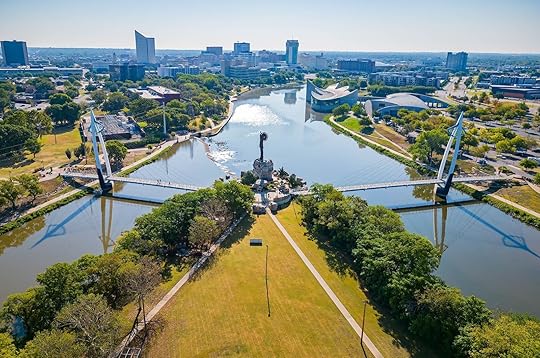
Wichita, the most populated city in Kansas, seems to be on the cusp of an Austin-like boom. Right now, it’s the final frontier of what you’d expect from a Midwest city, occupying that sweet spot between being affordable and traffic-free and still providing the sights and excitement of a booming city. That means now is the time to visit.
Plan to go in late spring or early summer if you want to catch Riverfest, Wichita’s longest running festival. Typically held during the first week in June, the free event is an extravaganza of music, food, and family fun. Early fall is another great time to go, especially if you want to add in a weekend road trip through southeast Kansas to experience small-town football traditions.
No matter the time of year you decide to visit, these are some of the best things to do in Wichita, plus where to eat and stay when you get there.
Things to do in WichitaFor everyoneKeeper of the Plains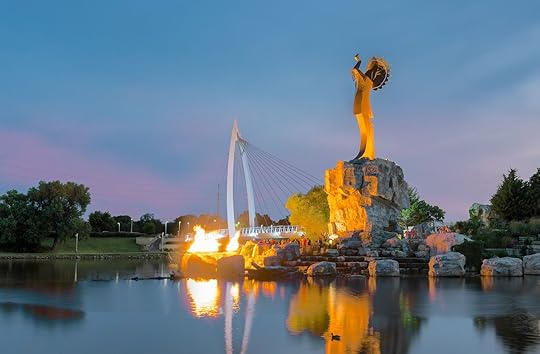
Photo: Nagel Photography/Shutterstock
The number one Wichita must-do is a visit to the Keeper of the Plains. The 44-foot statue by Kiowa-Comanche artist Blackbear Bosin stands above the point where the Little and Big Arkansas Rivers meet. During the day, the statue can be accessed from the Mid-America All-Indian Museum, but I’d recommend visiting in the evening.
On my first night in Wichita, I took the footbridge to the statue. After soaking in a bit of history from the plaza and getting up-close statue views, I walked back over the bridge and along the river until it was time for the Ring of Fire lighting. From the river, I watched the group of fire pits in front of the statue burn. The Ring of Fire lasts 15 minutes nightly, starting at 9 PM in spring and summer and 7 PM in fall and winter.
While exploring the next day, I kept my eyes peeled for Keepers on Parade, a project that commissions local artists to paint 10-foot replicas of the statue, which are then sprinkled all over the city. The Keeper of the Plains is open from 5 AM to midnight. Admission and parking (at Central Avenue and North Nims Avenue) is free.
Keeper of the Plains: 339 Veterans Pkwy, Wichita, KS 67203
Botanica
Photo:
photojohn830/Shutterstock
Confession time: The only class I ever failed was a botany class. Plant identification was my downfall. I actually failed it twice. I’ve never kept a plant alive before or since, yet I loved the quiet hour I spent wandering around Botanica.
The garden’s lush and shady 18 acres were full of flowers I couldn’t identify but delighted in nonetheless. The children’s park features a yellow brick road under the rainbow, a sweet nod to Oz. Also in the park is a carousel that used to be part of Joyland, a Wichita amusement park that closed in 2004.
Botanica is open from 9 AM to 5 PM on Mondays, Wednesdays, Fridays, and Saturdays. On Tuesdays and Thursdays, it stays open until 8 PM, and on Sundays, it opens at 1 PM. Tickets are $10, and parking is free. I’d recommend going during those Tuesday or Thursday evening hours when everything is quiet and cool.
Botanica: 701 Amidon St, Wichita, KS 67203
For familiesTanganyika Wildlife ParkView this post on InstagramA post shared by Tanganyika Wildlife Park (@tanganyikawildlifepark)
Tanganyika is smaller than most zoos and features fewer animals, but the tradeoff is more encounters. Admission includes the opportunity to feed five animals, like giraffes, lorikeets, or tortoises. There’s a petting zoo, playground, and summertime splash park (all included with admission). The wildlife park is located about 15 miles outside of Wichita and is a great spot to visit right after flying into town, as it’s near the airport. Spring and fall hours are 10 AM to 4 PM. Summer hours are 9 AM to 4 PM, and the park is closed during the winter. Tickets are $49.99 per adult and $39.99 per child, but you can save $10 per person by purchasing online.
Tanganyika Wildlife Park: 1000 S Hawkins Ln, Goddard, KS 67052
Exploration Place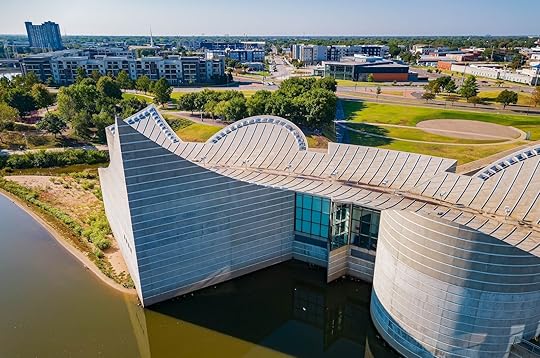
Photo: Kit Leong/Shutterstock
Wichita is known as the Air Capital of the World, thanks to its prolific aerospace manufacturing industry. It makes sense, then, that aviation is one of the focal points of this science center on the Arkansas River. Exploration place is open daily from 10 AM to 5 PM (8 PM on Thursdays and Fridays). Tickets are $20, and parking is free. Visitors can also catch a glimpse from the Keeper of the Plains statue from here.
Exploration Place: 300 N McLean Blvd, Wichita, KS 67203
Riverfront StadiumView this post on InstagramA post shared by Wichita Wind Surge (@windsurgeict)
Riverfront Stadium is the home of the Wichita Wind Surge, the Double A affiliate of the Minnesota Twins, hosting games from April to September. With a kid’s play area, between-innings entertainment, and endless hot dogs, nothing is more family friendly than a minor league baseball game. Check the schedule on the team’s website for game dates, as well as information on parking and public transportation.
Riverfront Stadium: 275 S McLean Blvd, Wichita, KS 67213
For cultureWichita Art MuseumView this post on InstagramA post shared by Wichita Art Museum (@wichitaartmuseum)
From powerful rotating exhibitions to a permanent collection featuring works by artists like Edward Hopper and Georgia O’Keeffe, this free museum is a must for anyone interested in American art. Closed Mondays and Tuesdays, the museum is open from 10 AM to 5 PM Wednesday through Sunday, with extended hours on Friday.
Wichita Art Museum: 1400 Museum Blvd, Wichita, KS 67203
Mid-America All-Indian MuseumView this post on InstagramA post shared by Mid-America All-Indian Museum (@midamericallindianmuseum)
This small museum mostly features art and information on Blackbear Bosin who designed the iconic Keeper of the Plains statue. Bosin’s cartoons, murals, and paintings are featured here along with exhibits that rotate quarterly. The museum doubles as a space for tribes to gather today, providing pictures and information about recent events and festivals. The museum is open Tuesday through Saturday from 10 AM to 4 PM. Admission is $7.
Mid-America All-Indian Museum: 650 N Seneca St, Wichita, KS 67203
Wichita-Sedgwick County Historical Museum
Photo: Kit Leong/Shutterstock
The Wichita-Sedgwick County Historical Museum takes visitors through Wichita history, from prairie wilderness to the Air Capital of the World statue. Walking through a replica of an 1890s house and mayor’s office is particularly delightful. I appreciated the dimes available to make a real phone call from a real phone booth on the first floor. If the prairie vibes of the museum strike your fancy, make your next stop the Old Cowtown Museum, an open-air living history museum. And if it’s Wichita’s aviation history that intrigues you, you can learn more at the Kansas Aviation Museum.
Wichita-Sedgwick County Historical Museum: 204 S Main St, Wichita, KS 67202
Chester I. Lewis Reflection SquareA short walk from the Wichita-Sedgwick County Historical Museum is a little pocket park that tells the story of how Civil Rights leader Chester I. Lewis guided successful student sit-ins at the Dockum lunch counter in 1958. The square’s mosaic map, which shows the history of redlining in Wichita, is particularly poignant. To learn more about Black history in Wichita, add the Kansas African American Museum to your to-do list, too. (Note that it’s moving to a new location at 201 North Main in downtown Wichita.)
Chester I. Lewis Reflection Square: 205 E Douglas Ave, Wichita, KS 67202
For shoppingDouglas Design DistrictView this post on InstagramA post shared by The Vault Collection (@thevaultcollection_)
Stretching along the east side of downtown, the shops on Douglas Avenue make up the Douglas Design District. Shop The Vault for mid-century modern or Art Deco pieces for your home, and peruse Watermark Books for your next read.
Heading west on Douglas Avenue, you’ll find something of an arts district. Visit The Workroom, a two-story store with curated gifts and home decor on the first floor and spaces for individual storefronts on the second floor. For fine art, check out Gallery 12, Wichita’s first cooperative gallery.
Douglas Design District: 1336 E Douglas Ave, Wichita, KS 67214
RevolutsiaView this post on InstagramA post shared by Revolutsia (@revolutsiaict)
If you prefer to do your shopping inside shipping containers, head to Revolutsia, where 36 shipping containers make up a shopping plaza. After loading up on romance novels from Blush Bookstore or new grips for your bike at Prairie.Bike, hang out around the community fire pit or head to Prost and enjoy kartoffelpuffer (German potato pancakes) or Jägerschnitzel (pork or veal cutlets) on one of the restaurant’s Oktoberfest-style benches. Most shops and Prost are closed Mondays.
Revolutsia: 2721 E Central Ave, Wichita, KS 67214
Where to eat and drink in WichitaWichita Brewing CompanyView this post on InstagramA post shared by Wichita Brewing Company (@wichitabrewing)
The Wichita Brewing Company launched in 2011 when two home brewers decided to bring their beer to the good people of Wichita. They’ve since expanded into two restaurants, as well as a canning and distribution center. When I arrived and plunked myself down at the bar, an old guy sitting nearby assured me that I’d found the best beer in Wichita. He insisted I order the 5:02 Amber.
Never one to discount beer advice from old guys, I followed orders. We clicked our glasses, and I soon appreciated his recommendation. The light caramel beer went perfectly with my Cajun bacon ranch pizza. The old guy disapproved of my pizza choice, as the alfredo sauce was indicative of strange city folks, but I thought it was delicious. In March, you can run a marathon between the brewing company’s two locations, if you can stomach running 26.2 miles between slices and pints.
Wichita Brewing Company: 8815 W 13th St N, Suite 100, Wichita, KS 67212 & 535 N Woodlawn St, Wichita, KS 67208
Mort’s Cigar and Whisky BarView this post on InstagramA post shared by Mort's Martini Bar (@mortsmartinibar)
After a busy weekend, Old Town Wichita is typically quiet on Mondays. But if people are out, they’re probably at Mort’s Cigar and Whisky Bar for the half-priced Martini Mondays. Follow the sound of restaurant chatter, and you’ll end up at a little building with a big porch. One hundred years ago it was a gas station, and 30 years ago it became Mort’s. Signs indicate that tables are for sharing, but feeling shy, I squeezed onto a barstool, ordered a pink martini, and lamented my dislike of cigars. Inside is full of TV screens and black-and-white photos of famous patrons. Outside is a year-round patio, often with live music. Note that there’s a $2 cover charge.
Mort’s Cigar and Whisky Bar: 923 E 1st St N, Wichita, KS 67202
HomeGrownView this post on InstagramA post shared by HomeGrown Wichita (@homegrownwichita)
The next day, I enjoyed an avocado-toasted brunch at HomeGrown, a daytime eatery with locally sourced ingredients right on Naftzger Park. (The restaurant also has West Wichita and Bradley Fair locations.) HomeGrown is open for breakfast, brunch, and lunch, with a long list of sweet and savory options for your first meal of the day, as well as sandwiches, soups, and salads. Beverages range from caffeinated or boozy to juicy and refreshing. Be sure to check out the seasonal offerings to see what specialty dishes HomeGrown has in store when you visit.
HomeGrown at Naftzger Park: 645 E. Douglas, Suite 102 Wichita, KS 67202
Public at the BrickyardView this post on InstagramA post shared by Public (@publicoldtown)
Public at the Brickyard has a tucked-away feel. You go down a set of steps before choosing your path: left towards the restaurant or right to The Brickyard, a small outdoor music venue with a stage rising above the red-brick courtyard that’s full of tables. The restaurant is a bit of a treasure hunt, featuring historical Wichita details and concert posters. Don’t miss the homemade pickle board or the pork bao appetizers. Public is closed Mondays and only open for special events on Sundays.
Public at the Brickyard: 129 N Rock Island Ave, Wichita, KS 67202
DockumView this post on InstagramA post shared by Dockum (@dockumwichita)
For after-dinner drinks, I headed half a mile west from Wichita’s Old Town to Dockum, a speakeasy-style cocktail bar. After finding the Siena Tuscan Steakhouse and taking the elevator down, I ignored the “Closed: Violation of National Prohibition Act” sign and knocked on the door to my left.
Even though prohibition is long gone, it was still a relief to be let in. The dark bar has an extensive drink list. I had a refreshing Cucumber Cure. The steakhouse is the former site of a Dockum Drugstore, where Chester I. Lewis inspired students to stage a sit-in during the summer of 1958 to protest segregation. The three-week sit-in was successful, and Lewis arranged for the students to meet with NAACP leaders across the South. Sit-ins spread following the Wichita success at Dockum.
Dockum: 104 S Broadway, Wichita, KS 67202
Where to stay in WichitaHotel at Old TownView this post on InstagramA post shared by Hotel at Old Town (@hotelatoldtownwichita)
The recently renovated Hotel at Old Town was once a warehouse that morphed into a hotel in 1999. The lobby features a brick facade and fountains that give it an expansive outdoor feel. The rotary phones, exposed brick walls, and historic memorabilia extend the feeling that you’re stepping into another era, particularly on Friday and Saturday nights when live jazz music plays from the 1906 Bar & Lounge.
The hotel’s name is a nod to the building, which opened in 1906 as a four-story warehouse facility for Keen Kutter, a tool and hardware company. Many of those tools have been tracked down and are now featured in historic displays around the hotel. Wichita’s history as the Air Capital of the World is also celebrated on the hotel’s Aviation Floor, where the hallways are filled with artifacts and photographs from the Kansas Aviation Museum.
Hotel at Old Town: 830 E 1st St N, Wichita, KS 67202
How to get to and around Wichita
Photo: Sean Pavone/Shutterstock
The Wichita Airport (ICH) hosts direct flights from 16 different cities, including LA, Seattle, Washington, DC, and Chicago. Rental cars can be easily picked up at the airport, and the drive to downtown is less than 10 minutes.
Once you’re in Wichita, it would be helpful to have a rental car. While the Old Town is walkable, and public transportation routes can get you downtown, sites like the Tanganyika Wildlife Preserve and Douglas Design District are best accessed by car. Parking is ample and free, and the streets are easy to navigate. 
Coolest Kissimmee Vacation Rentals for Families
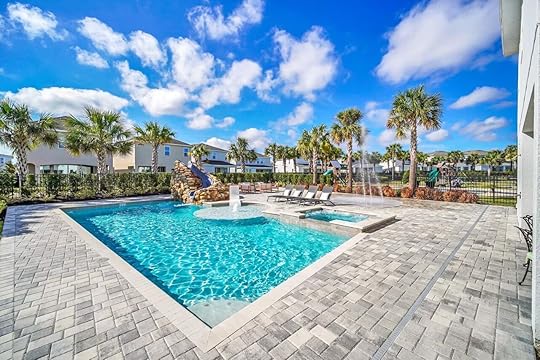
Twenty miles south of Orlando, Kissimmee is a hub for family vacations in Florida. Walt Disney World Resort is a 15-minute drive from the lakeside city which makes an equally convenient base for LEGOLAND Florida, Peppa Pig Theme Park, Cape Canaveral, and the Atlantic coast. The “Vacation Home Capital of the World” isn’t short on thrilling rentals with themed bedrooms to delight toddlers through to grandparents. These are the coolest Kissimmee vacation rentals for families in Florida’s entertainment capital.
Family house with Mickey and Moana-themed bedrooms
Traveling to Orlando, Universal Studios, or Disney World? Check out Matador’s guides to the best places to stay in the area: 8 of the coolest Airbnbs near Disney World, Florida These Disney World Airbnbs Are Rated The Best By Guests 15 beautiful Florida Airbnbs for every type of traveler 6 Kissimmee Airbnbs for a multi-generational family Disney trip Bookend your Disney trip at these beautiful Orlando airport hotels The best 11 Airbnbs near Universal Studios 10 family-friendly Orlando resorts minutes from all major theme parks These downtown Orlando hotels put you near the best of the city center Top Orlando Airbnbs with a pool for the ultimate Florida getaway These Airbnbs put you a stone’s throw from Peppa Pig Theme Park These Walt Disney World Resort hotels deliver an epic parks experience
 Photo:
Photo:  Photo:
Photo:  Photo:
Photo:  Photo:
Photo: One of the best Kissimmee vacation rentals for multigenerational families, has a Moana-themed bunk room and a Mickey and Minnie’s Jungle Safari suite. The remaining rooms come with upholstered beds and private bathrooms. Gather downstairs to finesse your air hockey skills in the Star Wars games room or partake in Disney rewatches over popcorn in the movie theater. The screened-in patio has a pool and spill-over hot tub.
Eleven guests, five bedrooms
Price: $880 per night
 Photo:
Photo:  Photo:
Photo:  Photo:
Photo:  Photo:
Photo: Designed for anyone who never wants to grow up, has a swashbuckling bedroom to rival the Pirates of the Caribbean ride. The rest of the home is elegantly appointed with heavy wooden moveables and antique collectibles. The pool has a slide, fountains, and splash pads to offset Florida’s baking-hot summers. Back inside, you’ll find a games room stocked with air hockey and ping pong.
Fourteen guests, six bedrooms
Price: $361 per night
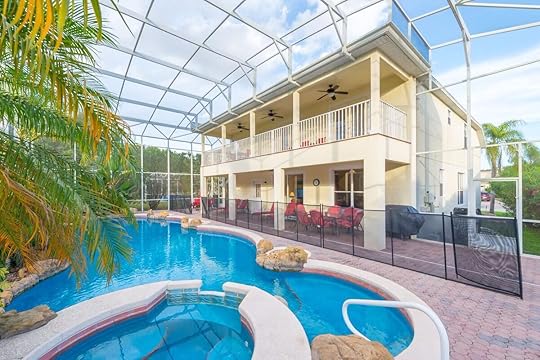 Photo:
Photo: 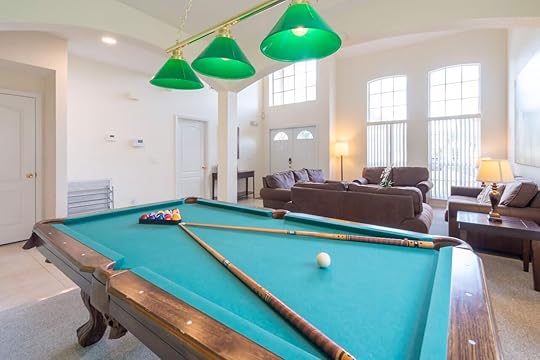 Photo:
Photo:  Photo:
Photo:  Photo:
Photo: Hanging off the edge of the championship-rated Highlands Reserve Golf Club, this golfer’s paradise has a landscaped pool with a second-floor lanai overlooking the tropical reserve. A safety net and pool alarm system provide peace of mind for parents. leaving space for two cars on the driveway. Disney, Orlando Tree Trek Adventure Park, and Old Town are 30 minutes or less.
Twelve guests, five bedrooms
Price: $326 per night
 Photo:
Photo:  Photo:
Photo:  Photo:
Photo:  Photo:
Photo: This family-friendly Vrbo with themed kids’ bedrooms might be even more exciting than getting a selfie with Mickey. Little ones can toss coins for Moana, Spiderman, Indiana Jones, and Star Wars while teens – and let’s be honest, adults – will be googly-eyed for the gamer’s bedroom. has a private pool, games room, and home cinema for everyone to enjoy. Kissimmee Airport is a five-minute drive and you’re spoiled for choice in terms of restaurants and attractions.
Twenty-two guests, 10 bedrooms
Price: $369 per night
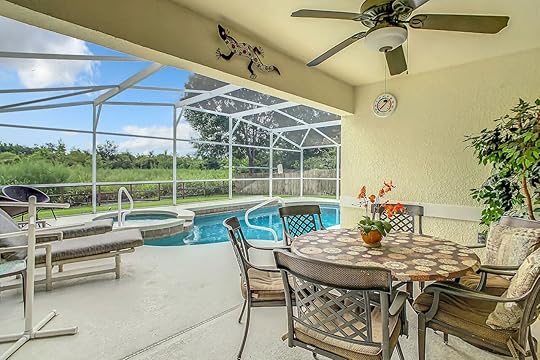 Photo:
Photo:  Photo:
Photo:  Photo:
Photo:  Photo:
Photo: While many Kissimmee rentals cater to dynasties, this top-rated Vrbo from a premier host is tailored for smaller clans of eight. Minutes from Medieval Times, has traditional decor and one Mickey Mouse-themed bedroom. The screened-in pool and hot tub back onto a peaceful reserve in the Whispering Oaks community. It’s close to all the attractions yet a far cry from bustling Orlando.
Eight guests, four bedrooms
Price: $150 per night
 Photo: Vrbo
Photo: Vrbo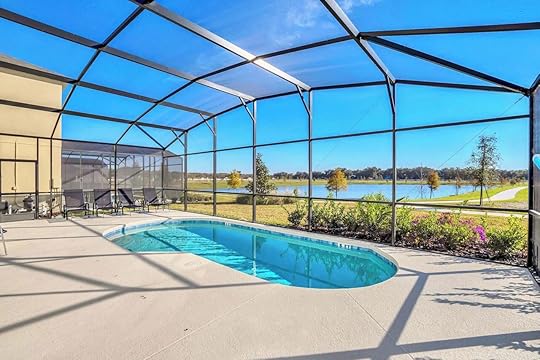 Photo: Vrbo
Photo: Vrbo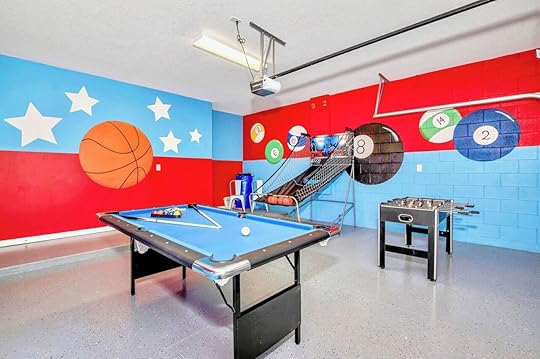 Photo: Vrbo
Photo: Vrbo Photo: Vrbo
Photo: VrboSee more photosThis luxurious house at Kissimmee’s Bella Vida Resort is full of Floridian charm. It has a private pool with enviable views of the lake plus a spacious sun deck with barbecue facilities. If you need a change of scene, dive into the resort pool or take the kids on a nature walk. There’s a games room with arcade basketball and two themed bedrooms for children. As for the location – Tinker Bell, Peppa, and Co are practically neighbors.
Seventeen guests, eight bedrooms
Price: $264 per night
 Photo: Vrbo
Photo: Vrbo Photo: Vrbo
Photo: Vrbo Photo: Vrbo
Photo: Vrbo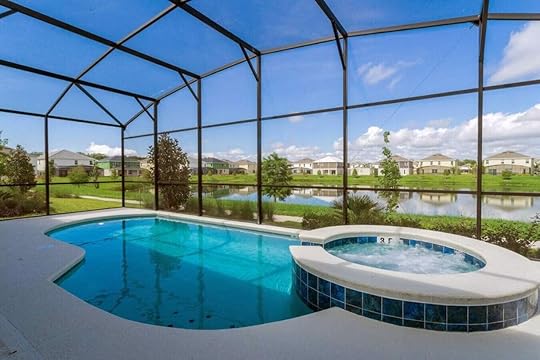 Photo: Vrbo
Photo: VrboSee more photosAnother whopping big Vrbo in Kissimmee for large groups, this family-friendly vacation house has Harry Potter, Minions, and Disney Princess-themed rooms to squabble over. Venture over to the dark side in the home cinema and see how many rewatches you can tick off. The pool and hot tub overlook the resort lake, a welcome sight after a thrill-packed day at theme parks and airboating alligator-infested swamps.
Twenty-three guests, ten bedrooms
Price: $316 per night
 Photo:
Photo:  Photo:
Photo:  Photo:
Photo:  Photo:
Photo: It looks like a regular suburban home on the outside but is a castle indoors. The open-concept lounge has a sumptuous settee overlooked by a state-of-the-art kitchen. Kids can sleep in enchanted carriage beds or Spiderman bunks whereas teens will be starry-eyed for the Star Wars suite. There’s a Mickey Mouse-themed games room and heated pool plus complimentary use of the resort’s water slides and lazy river.
Twenty guests, nine bedrooms
Price: $468 per night
 Photo: Vrbo
Photo: Vrbo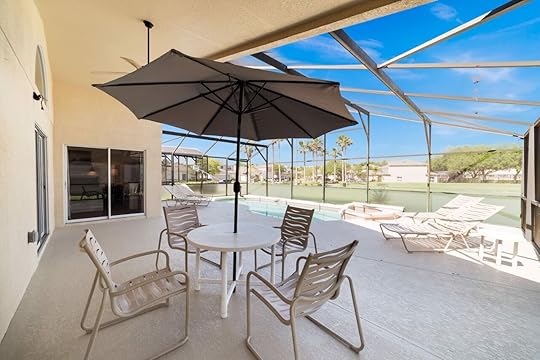 Photo: Vrbo
Photo: Vrbo Photo: Vrbo
Photo: Vrbo Photo: Vrbo
Photo: VrboSee more photosThis 10/10 rental is one of the closest Vrbos for Disney World. It has a swimming pool and jacuzzi sunken on a screened porch with ample seating for a post-theme park debrief. The airy master bedroom has an en suite with a heart-shaped corner tub, perfect for a bubble bath. Cook anything you want in the state-of-the-art kitchen or rent a barbecue grill. Baby essentials are provided free of charge.
Eight guests, four bedrooms
Price: $208 per night
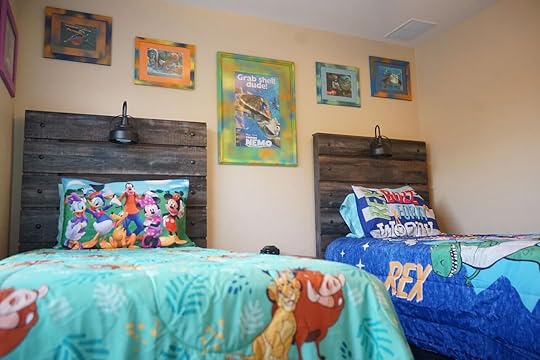 Photo: Vrbo
Photo: Vrbo Photo: Vrbo
Photo: Vrbo Photo: Vrbo
Photo: Vrbo Photo: Vrbo
Photo: VrboSee more photosLongtime fans will be “Buzzed” to see posters from classic Disney and Pixar movies plastered all over this lakeside townhome. Whether for kids or adults, all beds are wrapped in cartoon linens while shower curtains will inspire a morning sing-a-long. The rental is part of a luxury resort with five pools and a clubhouse where kids can trade trivia and practice their cannonballs. Don’t be afraid of the mice in the kitchen – they’re old friends.
Seven guests, four bedrooms
Price: $112 per night
 Photo:
Photo:  Photo:
Photo: 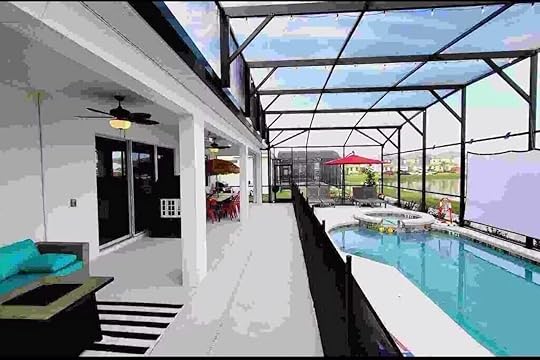 Photo:
Photo:  Photo:
Photo: Aye aye, the more the merrier at for multiple families with a taste for the high seas. Besides cartoon-themed kids’ bedrooms, adults can fall asleep on the sets of Game of Thrones, Buffy the Vampire Slayer, Stranger Things, and Breaking Bad. There’s a private Mickey Mouse clubhouse for tots and a pirate ship movie theater with space for everyone to come aboard. Not forgetting a lovely pool with a projector screen.

Thirty-eight guests, 15 bedrooms
Price: $595 per night
TSA Makes Travel More Convenient With Digital IDs Now Accepted in 11 States

Regardless of how prepared you are for navigating the airport, long queues, cumbersome security checks, and the constant fear of missing flights are almost guaranteed. And believe it or not, the TSA doesn’t like it any more than we do. Recently, the agency published a list of helpful tips to streamline the screening process just in time for the chaos of Labor Day travel, and last month, it was announced that the TSA is adding Hawai’i as the 11th state from which it will accept digital identification at certain checkpoints.
“We are pleased to have partnered with the Hawai’i Department of Transportation to make the digital ID a reality in the Aloha State. This is another way of integrating technology into the aviation security process at no additional cost to the passenger,” says TSA federal security director for Hawai’i, Nanea Vasta.
The Digital ID program is designed to simplify the airport security screening process by eliminating the need to present traditional driver’s licenses or state IDs physically. Instead, participants can use their smartphones to display a digital version of identification, which can be verified by TSA officers using advanced biometric technology.
Travelers with ID cards from these 11 states can add their info to their Apple Wallet.
ArizonaCaliforniaColoradoGeorgiaHawai’iIowaMarylandNevadaNew YorkOhioUtahAs more states adopt digital identification technology, the program is likely to continue growing and expanding in the coming years. However, it is still in early development. Only select airports are piloting digital ID technology. Before flying, make sure you check TSA’s list of participating airports. You can not travel internationally with a digital ID, but if you want to try it out and reside in one of the 11 states, it’s pretty simple to set up.
To participate in the Digital ID program, you must first download a compatible mobile app, such as the TSA Mobile app or the state-specific app provided by your respective state government. Once downloaded, you can add your digital driver’s license or state ID to the app by following the on-screen instructions.
It’s also worth noting that TSA PreCheck and the Digital ID program are not linked. You don’t need to apply and be accepted for PreCheck to get through security with your phone. 
TSA Makes Travel More Convenient With Digital IDs Now Excepted in 11 States

Regardless of how prepared you are for navigating the airport, long queues, cumbersome security checks, and the constant fear of missing flights are almost guaranteed. And believe it or not, the TSA doesn’t like it any more than we do. Recently, the agency published a list of helpful tips to streamline the screening process just in time for the chaos of Labor Day travel, and last month, it was announced that the TSA is adding Hawai’i as the 11th state from which it will accept digital identification at certain checkpoints.
“We are pleased to have partnered with the Hawai’i Department of Transportation to make the digital ID a reality in the Aloha State. This is another way of integrating technology into the aviation security process at no additional cost to the passenger,” says TSA federal security director for Hawai’i, Nanea Vasta.
The Digital ID program is designed to simplify the airport security screening process by eliminating the need to present traditional driver’s licenses or state IDs physically. Instead, participants can use their smartphones to display a digital version of identification, which can be verified by TSA officers using advanced biometric technology.
Travelers with ID cards from these 11 states can add their info to their Apple Wallet.
ArizonaCaliforniaColoradoGeorgiaHawai’iIowaMarylandNevadaNew YorkOhioUtahAs more states adopt digital identification technology, the program is likely to continue growing and expanding in the coming years. However, it is still in early development. Only select airports are piloting digital ID technology. Before flying, make sure you check TSA’s list of participating airports. You can not travel internationally with a digital ID, but if you want to try it out and reside in one of the 11 states, it’s pretty simple to set up.
To participate in the Digital ID program, you must first download a compatible mobile app, such as the TSA Mobile app or the state-specific app provided by your respective state government. Once downloaded, you can add your digital driver’s license or state ID to the app by following the on-screen instructions.
It’s also worth noting that TSA PreCheck and the Digital ID program are not linked. You don’t need to apply and be accepted for PreCheck to get through security with your phone. 
Matador Network's Blog
- Matador Network's profile
- 6 followers



